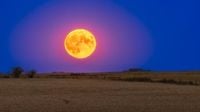The night sky is set to dazzle skywatchers once again as the Buck Moon, the first full moon of astronomical summer in the Northern Hemisphere, prepares to rise on Thursday, July 10, 2025. This lunar event promises to be one of the most captivating sights of the year, not only because of its timing but also due to its unique position and striking appearance.
The Buck Moon officially reaches its full phase at 4:38 p.m. Eastern Daylight Time on July 10. However, for observers in North America and parts of Europe, the best time to witness this spectacle will be at moonrise during dusk on the same evening. As the moon ascends on the eastern horizon, it will glow with a vibrant orange hue, creating a stunning orb that is sure to catch the eye of anyone looking skyward.
One of the most intriguing aspects of the Buck Moon is its unusually low position in the sky. It is set to be the second-lowest full moon of the year, surpassed only by June 11’s Strawberry Moon, which was the lowest in over 18 years. This phenomenon occurs because a full moon appears opposite the sun in the sky. Since the sun reached its highest point during the summer solstice on June 20, 2025, the moon mirrors this by positioning itself near the horizon, creating a low-hanging full moon.
This low position not only makes the Buck Moon a spectacular sight but also enhances its apparent size and color through a phenomenon known as the "moon illusion." When the moon is close to the horizon, our brains perceive it as larger than when it is high overhead. Additionally, the moon’s light passes through more of Earth’s atmosphere at this angle, scattering shorter wavelengths and causing the moon to appear a rusty red or orange shade, much like the Strawberry Moon did last month.
Adding to its uniqueness, this year’s Buck Moon will be the farthest full moon from the sun. This is because Earth reached aphelion—the farthest point from the sun in its elliptical orbit—on July 3, 2025. Since the full moon occurs on the side of Earth facing away from the sun, it will be at its most distant point from the sun this year, enhancing its brightness and size in the night sky.
The Buck Moon carries a rich tapestry of names and meanings. Its primary name derives from the time of year when male deer, or "bucks," begin to grow new antlers in North America. This natural cycle has inspired the moon’s moniker, connecting lunar events with terrestrial wildlife rhythms. Other traditional names for July’s full moon include the Salmon Moon, Raspberry Moon, Thunder Moon, and the Hay Moon—named for its proximity to the midsummer harvest. Celtic cultures also referred to it as the Claiming Moon, Wyrt Moon, Herb Moon, and Mead Moon, highlighting its significance across various traditions.
For those eager to catch the Buck Moon in its full glory, a clear view of the eastern horizon at dusk on July 10 is essential. In the United Kingdom, for instance, sunset will occur around 9:37 p.m. British Summer Time, with the moon rising shortly after at approximately 10 p.m. Observers are advised to find locations free from tall trees and buildings to ensure an unobstructed view.
On the night of the Buck Moon, stargazers will also have the opportunity to spot the moon within the constellation Sagittarius, specifically near a star pattern affectionately known as the Teapot. While the moon’s brightness might make it challenging to spot the stars in this pattern, it remains a fascinating target for amateur astronomers.
Adding to the celestial show, three planets will be visible near the Buck Moon. Mars will be shining in the western sky before setting around 11:37 p.m. BST, positioned near the constellation Leo and the bright star Regulus. Saturn will rise just after midnight on July 11, offering early risers a chance to glimpse the ringed planet before dawn. Venus, the brightest planet in the night sky, will also make an appearance around 2 a.m., illuminating the eastern sky alongside Saturn.
This lunar event fits into a broader calendar of full moons throughout 2025. Starting with the Wolf Moon on January 13 and progressing through names such as the Snow Moon, Worm Moon, Pink Moon, Flower Moon, and the recent Strawberry Moon, the Buck Moon continues the tradition of naming each full moon after natural phenomena or seasonal markers. Following the Buck Moon, the Sturgeon Moon will rise on August 9, continuing the summer’s celestial rhythm.
Jamie Carter, a freelance journalist and astronomy expert based in Cardiff, UK, emphasizes the significance of such events. As he notes, the Buck Moon offers not just a visual treat but also a connection to the cycles of nature and the cosmos. "It’s a reminder of how our planet’s movements and natural rhythms intertwine, creating moments of beauty that have been observed and celebrated for generations," he explains.
For those interested in capturing the Buck Moon’s beauty, photography tips suggest focusing on the moonrise at dusk to take advantage of its enhanced size and color. Using a moon calculator can help pinpoint the exact time the moon will rise from any location, ensuring enthusiasts don’t miss this spectacular event.
As the Buck Moon rises low on the horizon, glowing with a fiery orange hue, it invites us to pause and appreciate the timeless dance between Earth, the sun, and our closest celestial neighbor. Whether viewed from a bustling city or a quiet countryside, this lunar spectacle is a reminder of the enduring wonder of the night sky.




